Power Consumption
Idle power consumption on 120V power we saw 29-34W idle for the six-core unit. We generally assume these nodes will use 9-12W idle so this was a bit higher but makes sense given the GPU. Again, these are used units so it may vary a bit.
The power supply for this unit is a 135W Lenovo power adapter from the company’s notebook line. This is bigger than a typical 65W power adapter we saw with previous generations and also bigger than the 90W units we saw in our Lenovo ThinkCentre M920 and M920q Tiny Guide and Review. This power is needed to drive the GPU and additional cooling. We did get our test unit to pull over 100W.
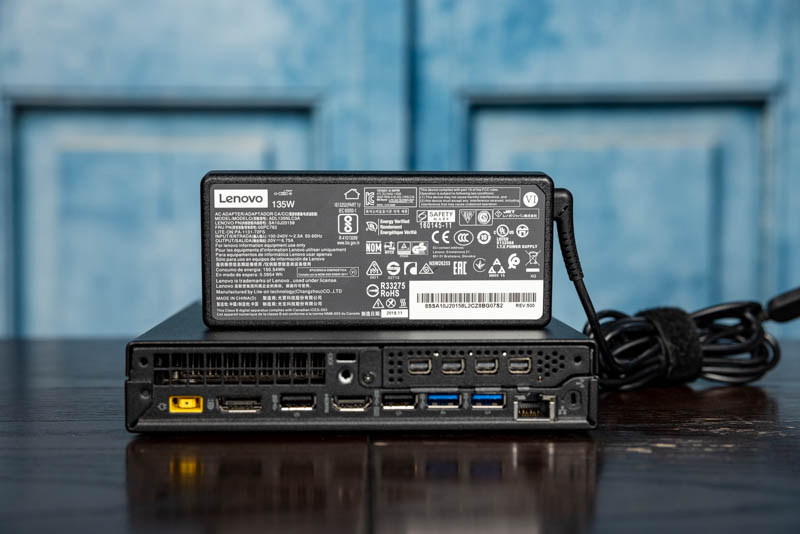
At idle, the noise is still relatively quiet. Under heavier loads, the fan spins up and the system is very audible. This is a function of having a CPU and GPU in a small package like this. There is little room to add elaborate cooling and larger quieter fans.
Next, we are going to discuss key lessons learned before getting to our final thoughts.
Key Lesson Learned for TMM
In this series, we wanted to also focus on some key lessons learned. Since we have already tested well over a dozen different models, we are taking away key pieces of advice from each that we wanted to share.
Something that we went into more detail on in our video, but we wanted to address is the comparison to the Apple Mac Mini M1. We have the 8GB/ 256GB base models in the lab, and a 16GB model en route. For comparison, we got our unit for $535 with 8GB of memory, no WiFi, a 128GB SSD, but also with the GPU and Windows 10 Pro license and vPro.
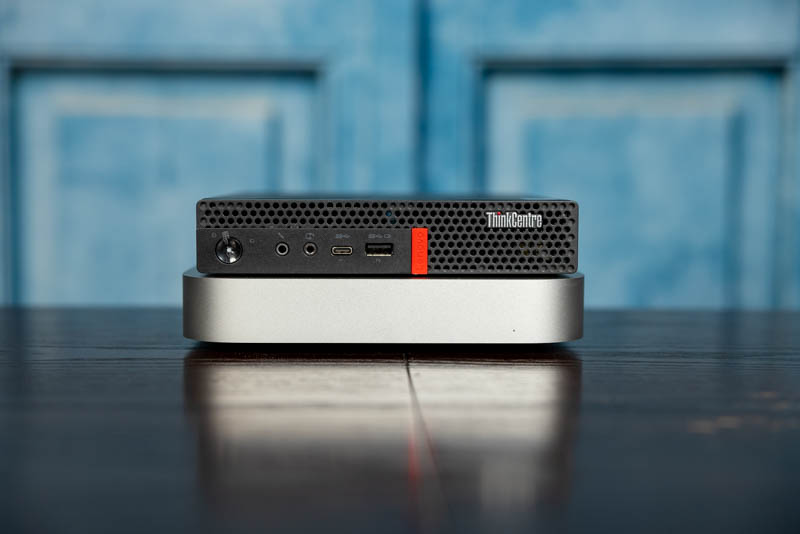
Size wise, these systems are very close. The Mac Mini M1 is noticeably larger, but it has an internal PSU while the Lenovo unit has an external 135W power brick that is very large. As one can see, while we get USB4 on the Mac Mini, the Lenovo unit we have simply has much more I/O connectivity both on the front and the rear. In terms of power and noise, the Mac Mini M1 is far superior.
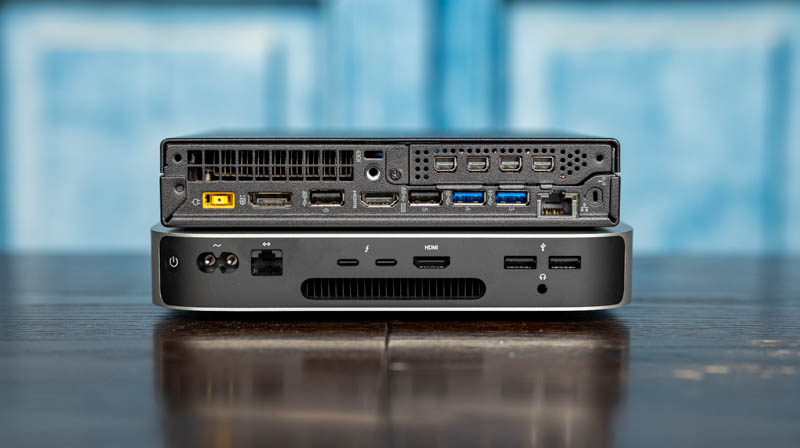
We are going to do a more thorough review of the Mac Mini M1 soon, but our initial observations in making the decision are this:
- If you are purchasing as a desktop and are OS agnostic, then the Apple Mac Mini M1 is likely a nicer unit as it is lower power and lower noise. At the same time, one can run eSports titles on the Radeon RX 560 and connect up to 6-displays. Both will give you a great desktop experience. Buying new, and without the AMD GPU, the desktop graphics experience feels better on the Mac Mini M1 versus the M920q Tiny we have.
- The Lenovo M920x Tiny has Intel vPro management. If you need a remote desktop and power on/off functionality, this is a better solution. For a corporate environment, this remote service capability is a huge feature, especially in these times if you are shipping these small systems to remote workers or locations as it minimizes in-person service calls.
- At some point, there is a MacOS v. Windows 10 Pro and Linux discussion that must happen. Running on standard x86 hardware means most OSes will just work. On the other hand, if you want MacOS, then the Mac Mini is clearly the option. This is basically a binary decision point.
- When it comes to expandability, it is not even close. We spent $200 more and are waiting what will be 2+ weeks for the 16GB Mac Mini M1 to add 8GB of memory since the unit is not user serviceable.
- Apple charges $200 for 8GB of memory where that is a $25-35 upgrade for the M920x Tiny. We can also go to 32GB (in-spec) or 64GB (out of spec but tested) in the Lenovo. The 64GB configuration costs around $200 so that is an enormous delta.
- On the storage side, even with the AMD GPU, we get two M.2 NVMe SSD slots. A 1TB NVMe SSD is $100-170 these days. Ordering a Mac Mini M1 with a 512GB SSD instead of a 256GB SSD is a $200 upgrade and ordering it with a 1TB SSD is a $400 upgrade. Lenovo has tool-less service options to add additional drives and capacity while Apple requires ordering a new unit.
- Going into higher-end configurations, the Lenovo M920x Tiny becomes a better value (if you do not need MacOS.)
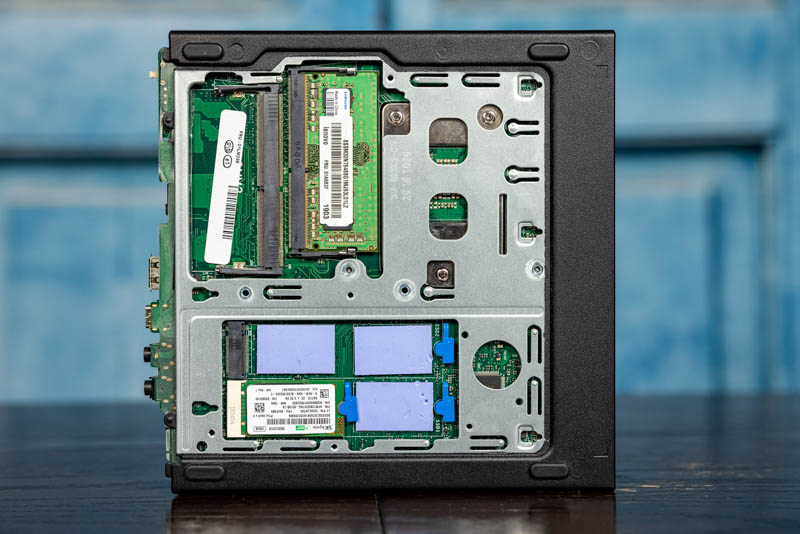
Overall, this question effectively boils down to if you want the Apple Mac Mini M1. If you do, then you likely want it for reasons the Lenovo M920x Tiny will never fill. If you are just looking for a general purpose small node, or one to expand upon, then the Lenovo M920x/ M920q Tiny is significantly better. Being frank here, if you were thinking of upgrading to a 16GB / 512GB Mac Mini M1, you may be better spent buying the 8GB/ 256GB model and then setting up one of these Lenovo units, without the GPU and used, as a server to offload functionality at a lower cost.
We are going to have more on the Mac Mini M1 after our 16GB model comes in, but we wanted to at least address this question we have been getting.
Final Words
Overall, this was a great system with some caveats. From an expandability perspective, this is a fabulous solution. From a serviceability perspective, Lenovo is ahead of HP and Dell with this generation’s design. Compared to Apple, Lenovo is on a completely different serviceability and upgradeability playing field.
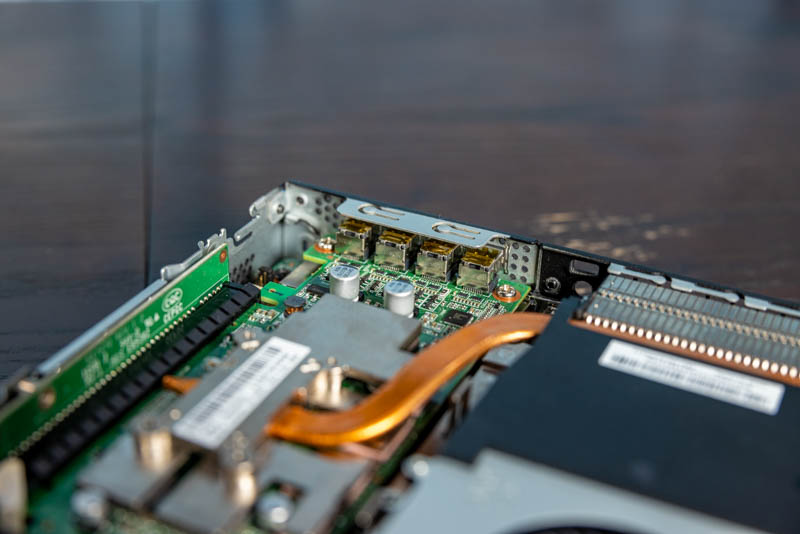
We purchased this configuration because it is one of the few with an AMD Radeon dGPU. We already reviewed the Lenovo ThinkStation P320 Tiny and did a Project TinyMiniMicro piece on it we also have the P330 Tiny in the TMM population. Having a dGPU but also a PCIe riser for some customizability is not going to be for everyone but it is something we sought so we could show it to our readers who have been asking about these types of solutions.
Given what we paid for this unit, it was perhaps not the best value, but there is something to be said for having a great package where the primary or only complaint is really that the optional AMD GPU is generating more power consumption and therefore cooling noise. Again, this is an option, so it is something to be aware of.
In the spectrum of Project TinyMiniMicro nodes, there are some that we like simply based on price. The Lenovo ThinkCentre M920x Tiny is one of, if not the best 1L TinyMiniMicro node in its generation from an overall capability perspective. It is simply in a different league than many of the other units we have tested from the big 3 when we take into account what we want in a small node like this.



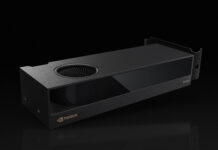
@Patrick – SHOWOFF!!!!!!!!
How the h… did you get hold of a geforce 3090gtx? 🙂 – hope we’ll see a review soon? Can see it’s a founders edition in the video, so i presume it was sent directly to you from Nvidia. 🙂
@Patrick Can this bad boy run run 10Gbe NIC instead of the RX 560? It’s the only thing that has kept me from pulling the trigger on this box, as it would be perfect for a small at-home 4 node vSAN deployment lab, especially with 8 Cores per unit.
@Saul – it should. However those graphicscards are quite specific to that model. https://psref.lenovo.com/Product/ThinkCentre/ThinkCentre_M920x_Tiny – look at “specifications” and you will see original support for a 4x Gigabit card, so if you find a 1x 10gig low profile card (since the card is running x4 slots and not x16/8, that would probably work as well. – no official support though.)
I am running a Mellanox ConnectX-3 (type CX311A) 10Gbps NIC in in m920q with a 01AJ940 riser card. Note: the top cover will not close completly if the braket is left on the NIC. Though it will be covered completly, but you notice that the cover doesn’t snap completely into place.
Hi!
I get one of this and I noticed that rx560 is the one with 896 shaders instead of the good one with 1024 shaders.
I tried https://www.techpowerup.com/forums/threads/unlock-the-shaders-amd-radeon-rx-560d.240735/page-2#post-3797614 to unlock all shaders but it looks hardware locked.
Did you notice that? Did you try to unlock all shaders?
Hey
Love the content, i am having trouble finding information as to whether or not this thing supports pcie bifurcation over pcie, thinking of getting a low profile pcie quad m.2 adaptor. But i believe it must support bifurcation for that to work 🙂
Cheers